PepsiCo Benchmarking: Analyzing Best Practices and Market Position
VerifiedAdded on 2021/04/17
|12
|2581
|1444
Report
AI Summary
This report provides an in-depth analysis of PepsiCo's benchmarking practices, focusing on its market position and competitive strategies within the food and beverage industry. The report begins with an introduction to benchmarking, explaining its importance in comparing business processes and performance. It identifies PepsiCo's primary competitor, Coca-Cola, and examines how PepsiCo uses benchmarking to assess its position in the market. The report discusses the selection of benchmarks, including quality of products, customer satisfaction, and industry best practices, and outlines the methodologies used for evaluation. It also explores different types of benchmarking, such as process, performance, and strategic benchmarking, and evaluates PepsiCo's performance against industry standards. The report concludes with recommendations for improving PepsiCo's benchmarking processes to enhance its market share and competitive advantage, emphasizing the importance of adapting best practices and effective communication within the organization. The analysis includes a comparison of PepsiCo's financial performance with Coca-Cola's, highlighting the impact of adopted measures on revenue and market position.
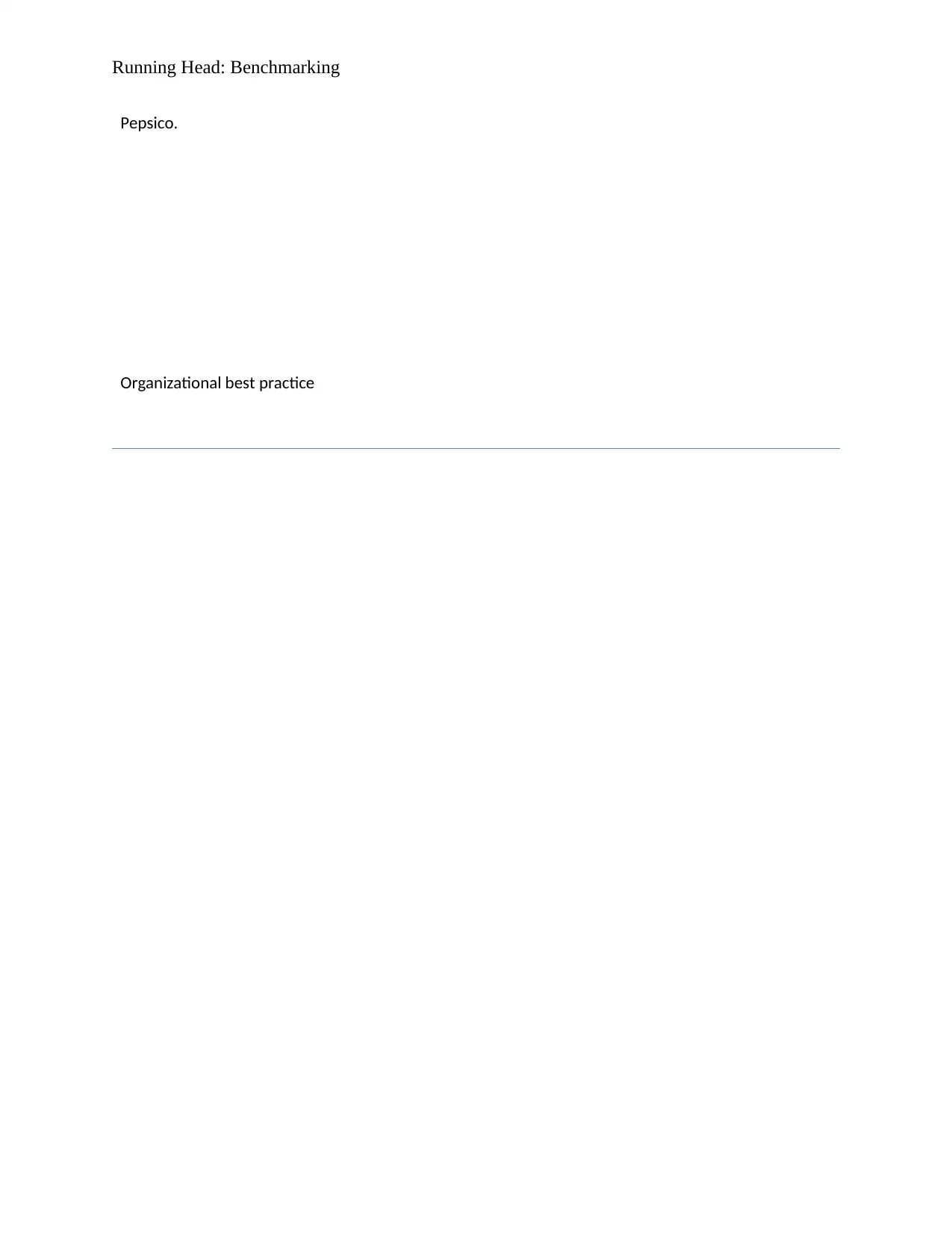
Running Head: Benchmarking
Pepsico.
Organizational best practice
Pepsico.
Organizational best practice
Paraphrase This Document
Need a fresh take? Get an instant paraphrase of this document with our AI Paraphraser
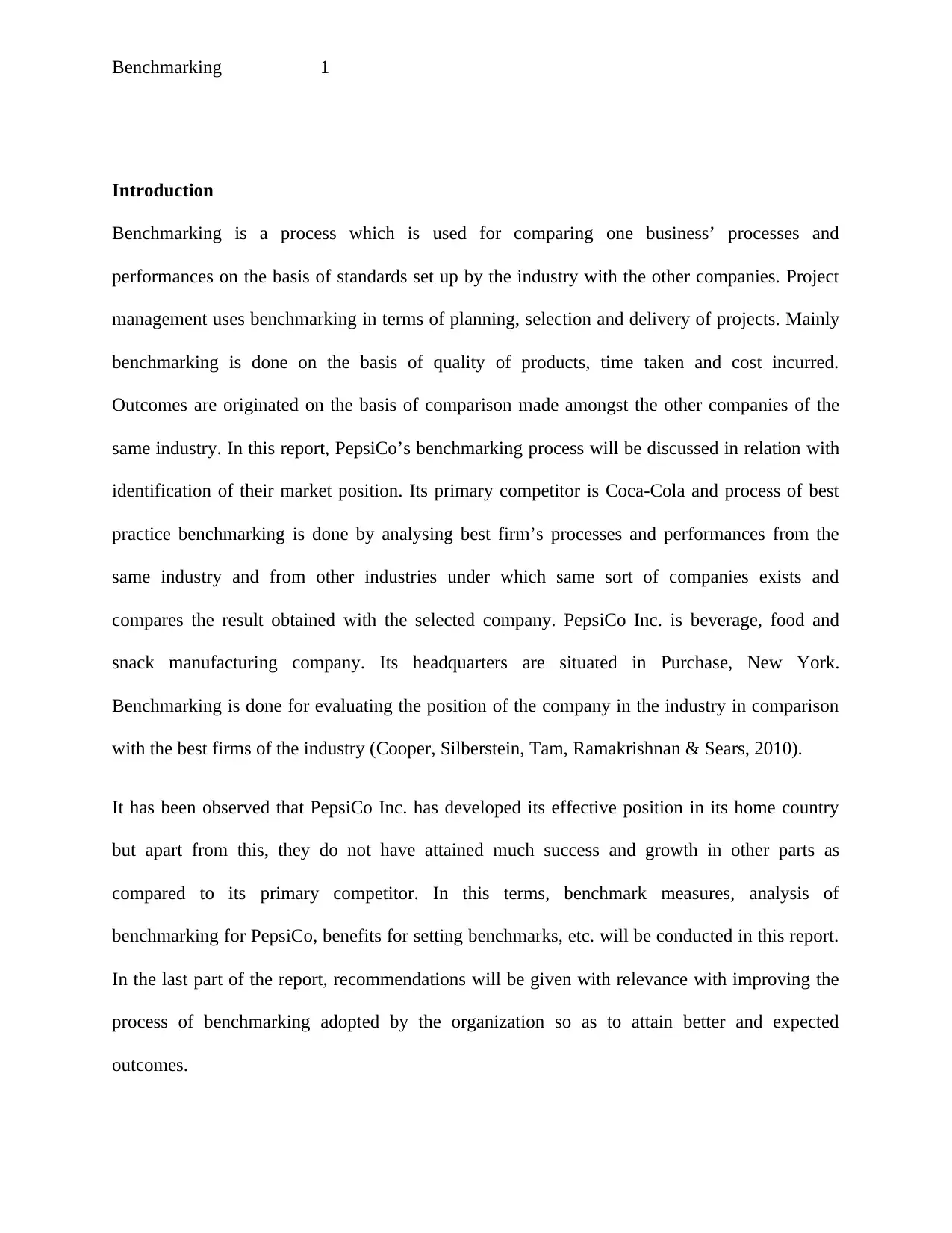
Benchmarking 1
Introduction
Benchmarking is a process which is used for comparing one business’ processes and
performances on the basis of standards set up by the industry with the other companies. Project
management uses benchmarking in terms of planning, selection and delivery of projects. Mainly
benchmarking is done on the basis of quality of products, time taken and cost incurred.
Outcomes are originated on the basis of comparison made amongst the other companies of the
same industry. In this report, PepsiCo’s benchmarking process will be discussed in relation with
identification of their market position. Its primary competitor is Coca-Cola and process of best
practice benchmarking is done by analysing best firm’s processes and performances from the
same industry and from other industries under which same sort of companies exists and
compares the result obtained with the selected company. PepsiCo Inc. is beverage, food and
snack manufacturing company. Its headquarters are situated in Purchase, New York.
Benchmarking is done for evaluating the position of the company in the industry in comparison
with the best firms of the industry (Cooper, Silberstein, Tam, Ramakrishnan & Sears, 2010).
It has been observed that PepsiCo Inc. has developed its effective position in its home country
but apart from this, they do not have attained much success and growth in other parts as
compared to its primary competitor. In this terms, benchmark measures, analysis of
benchmarking for PepsiCo, benefits for setting benchmarks, etc. will be conducted in this report.
In the last part of the report, recommendations will be given with relevance with improving the
process of benchmarking adopted by the organization so as to attain better and expected
outcomes.
Introduction
Benchmarking is a process which is used for comparing one business’ processes and
performances on the basis of standards set up by the industry with the other companies. Project
management uses benchmarking in terms of planning, selection and delivery of projects. Mainly
benchmarking is done on the basis of quality of products, time taken and cost incurred.
Outcomes are originated on the basis of comparison made amongst the other companies of the
same industry. In this report, PepsiCo’s benchmarking process will be discussed in relation with
identification of their market position. Its primary competitor is Coca-Cola and process of best
practice benchmarking is done by analysing best firm’s processes and performances from the
same industry and from other industries under which same sort of companies exists and
compares the result obtained with the selected company. PepsiCo Inc. is beverage, food and
snack manufacturing company. Its headquarters are situated in Purchase, New York.
Benchmarking is done for evaluating the position of the company in the industry in comparison
with the best firms of the industry (Cooper, Silberstein, Tam, Ramakrishnan & Sears, 2010).
It has been observed that PepsiCo Inc. has developed its effective position in its home country
but apart from this, they do not have attained much success and growth in other parts as
compared to its primary competitor. In this terms, benchmark measures, analysis of
benchmarking for PepsiCo, benefits for setting benchmarks, etc. will be conducted in this report.
In the last part of the report, recommendations will be given with relevance with improving the
process of benchmarking adopted by the organization so as to attain better and expected
outcomes.
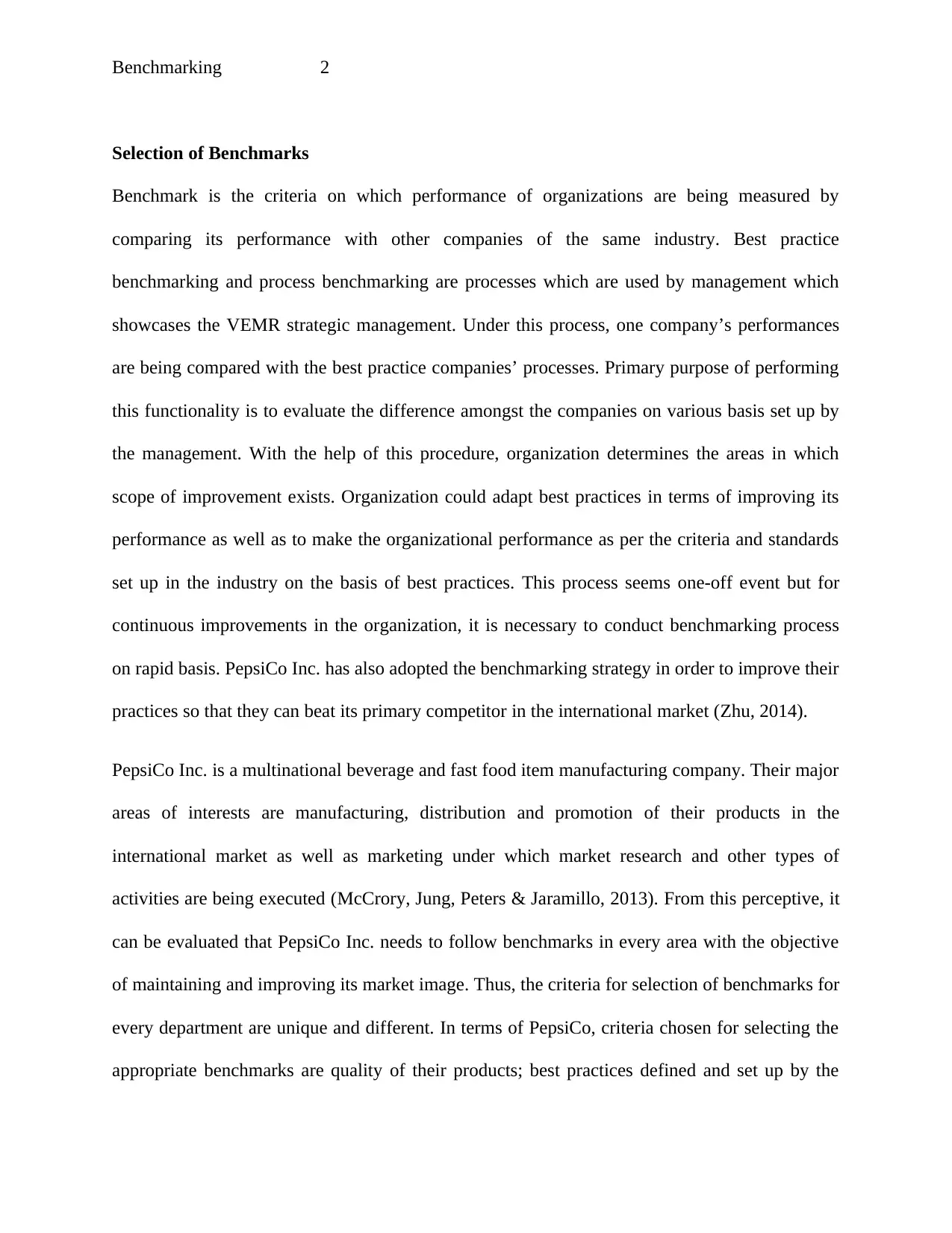
Benchmarking 2
Selection of Benchmarks
Benchmark is the criteria on which performance of organizations are being measured by
comparing its performance with other companies of the same industry. Best practice
benchmarking and process benchmarking are processes which are used by management which
showcases the VEMR strategic management. Under this process, one company’s performances
are being compared with the best practice companies’ processes. Primary purpose of performing
this functionality is to evaluate the difference amongst the companies on various basis set up by
the management. With the help of this procedure, organization determines the areas in which
scope of improvement exists. Organization could adapt best practices in terms of improving its
performance as well as to make the organizational performance as per the criteria and standards
set up in the industry on the basis of best practices. This process seems one-off event but for
continuous improvements in the organization, it is necessary to conduct benchmarking process
on rapid basis. PepsiCo Inc. has also adopted the benchmarking strategy in order to improve their
practices so that they can beat its primary competitor in the international market (Zhu, 2014).
PepsiCo Inc. is a multinational beverage and fast food item manufacturing company. Their major
areas of interests are manufacturing, distribution and promotion of their products in the
international market as well as marketing under which market research and other types of
activities are being executed (McCrory, Jung, Peters & Jaramillo, 2013). From this perceptive, it
can be evaluated that PepsiCo Inc. needs to follow benchmarks in every area with the objective
of maintaining and improving its market image. Thus, the criteria for selection of benchmarks for
every department are unique and different. In terms of PepsiCo, criteria chosen for selecting the
appropriate benchmarks are quality of their products; best practices defined and set up by the
Selection of Benchmarks
Benchmark is the criteria on which performance of organizations are being measured by
comparing its performance with other companies of the same industry. Best practice
benchmarking and process benchmarking are processes which are used by management which
showcases the VEMR strategic management. Under this process, one company’s performances
are being compared with the best practice companies’ processes. Primary purpose of performing
this functionality is to evaluate the difference amongst the companies on various basis set up by
the management. With the help of this procedure, organization determines the areas in which
scope of improvement exists. Organization could adapt best practices in terms of improving its
performance as well as to make the organizational performance as per the criteria and standards
set up in the industry on the basis of best practices. This process seems one-off event but for
continuous improvements in the organization, it is necessary to conduct benchmarking process
on rapid basis. PepsiCo Inc. has also adopted the benchmarking strategy in order to improve their
practices so that they can beat its primary competitor in the international market (Zhu, 2014).
PepsiCo Inc. is a multinational beverage and fast food item manufacturing company. Their major
areas of interests are manufacturing, distribution and promotion of their products in the
international market as well as marketing under which market research and other types of
activities are being executed (McCrory, Jung, Peters & Jaramillo, 2013). From this perceptive, it
can be evaluated that PepsiCo Inc. needs to follow benchmarks in every area with the objective
of maintaining and improving its market image. Thus, the criteria for selection of benchmarks for
every department are unique and different. In terms of PepsiCo, criteria chosen for selecting the
appropriate benchmarks are quality of their products; best practices defined and set up by the
⊘ This is a preview!⊘
Do you want full access?
Subscribe today to unlock all pages.

Trusted by 1+ million students worldwide
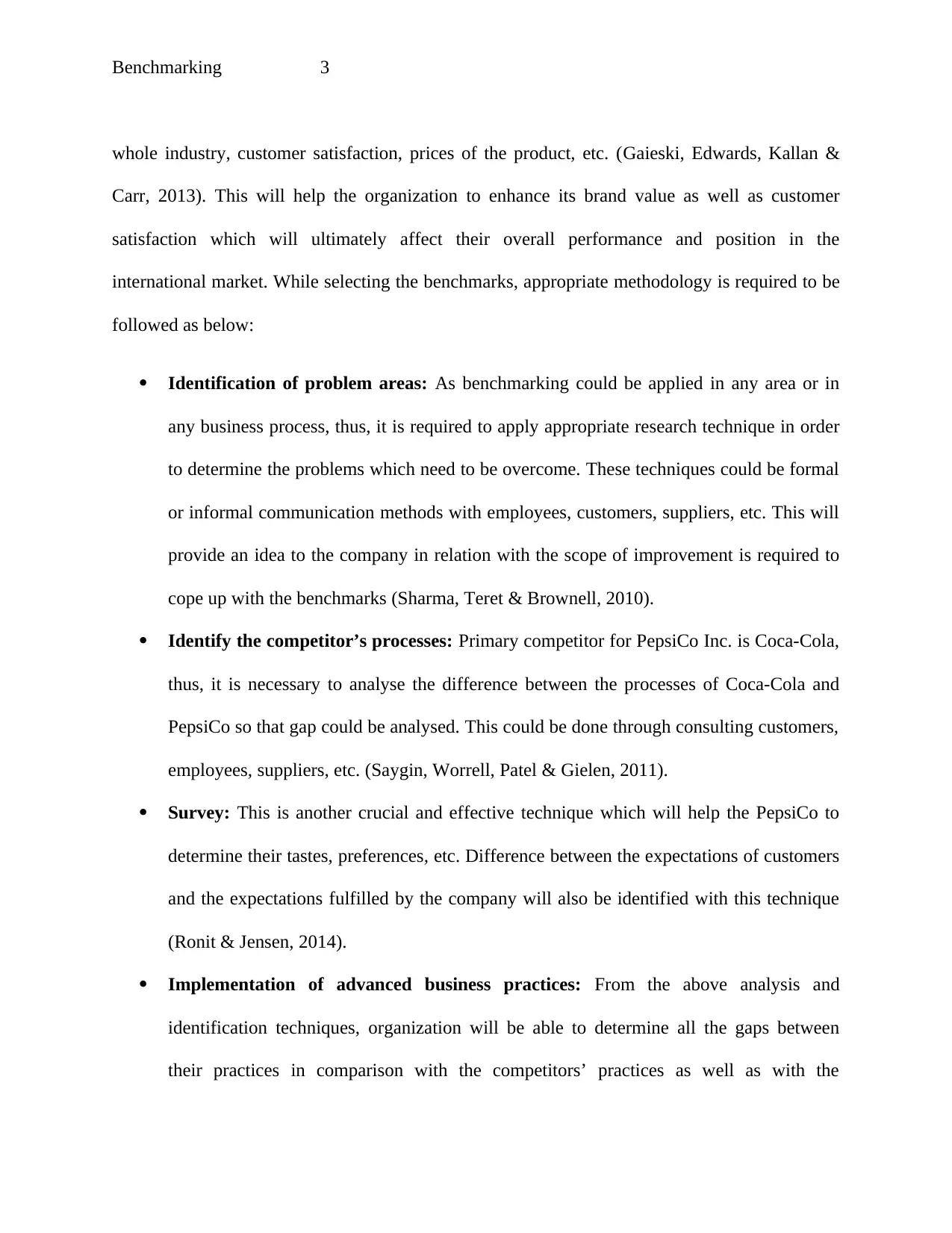
Benchmarking 3
whole industry, customer satisfaction, prices of the product, etc. (Gaieski, Edwards, Kallan &
Carr, 2013). This will help the organization to enhance its brand value as well as customer
satisfaction which will ultimately affect their overall performance and position in the
international market. While selecting the benchmarks, appropriate methodology is required to be
followed as below:
Identification of problem areas: As benchmarking could be applied in any area or in
any business process, thus, it is required to apply appropriate research technique in order
to determine the problems which need to be overcome. These techniques could be formal
or informal communication methods with employees, customers, suppliers, etc. This will
provide an idea to the company in relation with the scope of improvement is required to
cope up with the benchmarks (Sharma, Teret & Brownell, 2010).
Identify the competitor’s processes: Primary competitor for PepsiCo Inc. is Coca-Cola,
thus, it is necessary to analyse the difference between the processes of Coca-Cola and
PepsiCo so that gap could be analysed. This could be done through consulting customers,
employees, suppliers, etc. (Saygin, Worrell, Patel & Gielen, 2011).
Survey: This is another crucial and effective technique which will help the PepsiCo to
determine their tastes, preferences, etc. Difference between the expectations of customers
and the expectations fulfilled by the company will also be identified with this technique
(Ronit & Jensen, 2014).
Implementation of advanced business practices: From the above analysis and
identification techniques, organization will be able to determine all the gaps between
their practices in comparison with the competitors’ practices as well as with the
whole industry, customer satisfaction, prices of the product, etc. (Gaieski, Edwards, Kallan &
Carr, 2013). This will help the organization to enhance its brand value as well as customer
satisfaction which will ultimately affect their overall performance and position in the
international market. While selecting the benchmarks, appropriate methodology is required to be
followed as below:
Identification of problem areas: As benchmarking could be applied in any area or in
any business process, thus, it is required to apply appropriate research technique in order
to determine the problems which need to be overcome. These techniques could be formal
or informal communication methods with employees, customers, suppliers, etc. This will
provide an idea to the company in relation with the scope of improvement is required to
cope up with the benchmarks (Sharma, Teret & Brownell, 2010).
Identify the competitor’s processes: Primary competitor for PepsiCo Inc. is Coca-Cola,
thus, it is necessary to analyse the difference between the processes of Coca-Cola and
PepsiCo so that gap could be analysed. This could be done through consulting customers,
employees, suppliers, etc. (Saygin, Worrell, Patel & Gielen, 2011).
Survey: This is another crucial and effective technique which will help the PepsiCo to
determine their tastes, preferences, etc. Difference between the expectations of customers
and the expectations fulfilled by the company will also be identified with this technique
(Ronit & Jensen, 2014).
Implementation of advanced business practices: From the above analysis and
identification techniques, organization will be able to determine all the gaps between
their practices in comparison with the competitors’ practices as well as with the
Paraphrase This Document
Need a fresh take? Get an instant paraphrase of this document with our AI Paraphraser
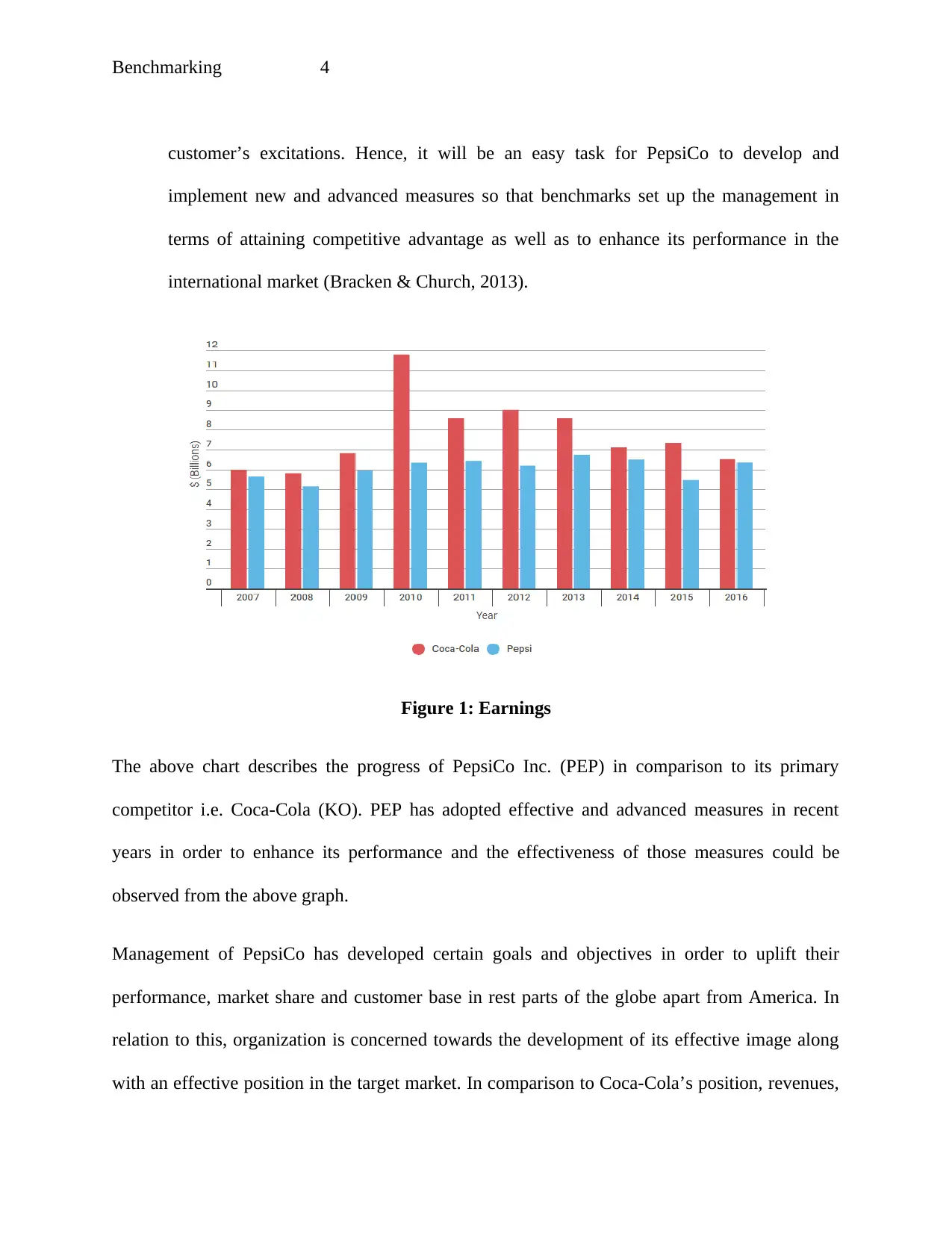
Benchmarking 4
customer’s excitations. Hence, it will be an easy task for PepsiCo to develop and
implement new and advanced measures so that benchmarks set up the management in
terms of attaining competitive advantage as well as to enhance its performance in the
international market (Bracken & Church, 2013).
Figure 1: Earnings
The above chart describes the progress of PepsiCo Inc. (PEP) in comparison to its primary
competitor i.e. Coca-Cola (KO). PEP has adopted effective and advanced measures in recent
years in order to enhance its performance and the effectiveness of those measures could be
observed from the above graph.
Management of PepsiCo has developed certain goals and objectives in order to uplift their
performance, market share and customer base in rest parts of the globe apart from America. In
relation to this, organization is concerned towards the development of its effective image along
with an effective position in the target market. In comparison to Coca-Cola’s position, revenues,
customer’s excitations. Hence, it will be an easy task for PepsiCo to develop and
implement new and advanced measures so that benchmarks set up the management in
terms of attaining competitive advantage as well as to enhance its performance in the
international market (Bracken & Church, 2013).
Figure 1: Earnings
The above chart describes the progress of PepsiCo Inc. (PEP) in comparison to its primary
competitor i.e. Coca-Cola (KO). PEP has adopted effective and advanced measures in recent
years in order to enhance its performance and the effectiveness of those measures could be
observed from the above graph.
Management of PepsiCo has developed certain goals and objectives in order to uplift their
performance, market share and customer base in rest parts of the globe apart from America. In
relation to this, organization is concerned towards the development of its effective image along
with an effective position in the target market. In comparison to Coca-Cola’s position, revenues,
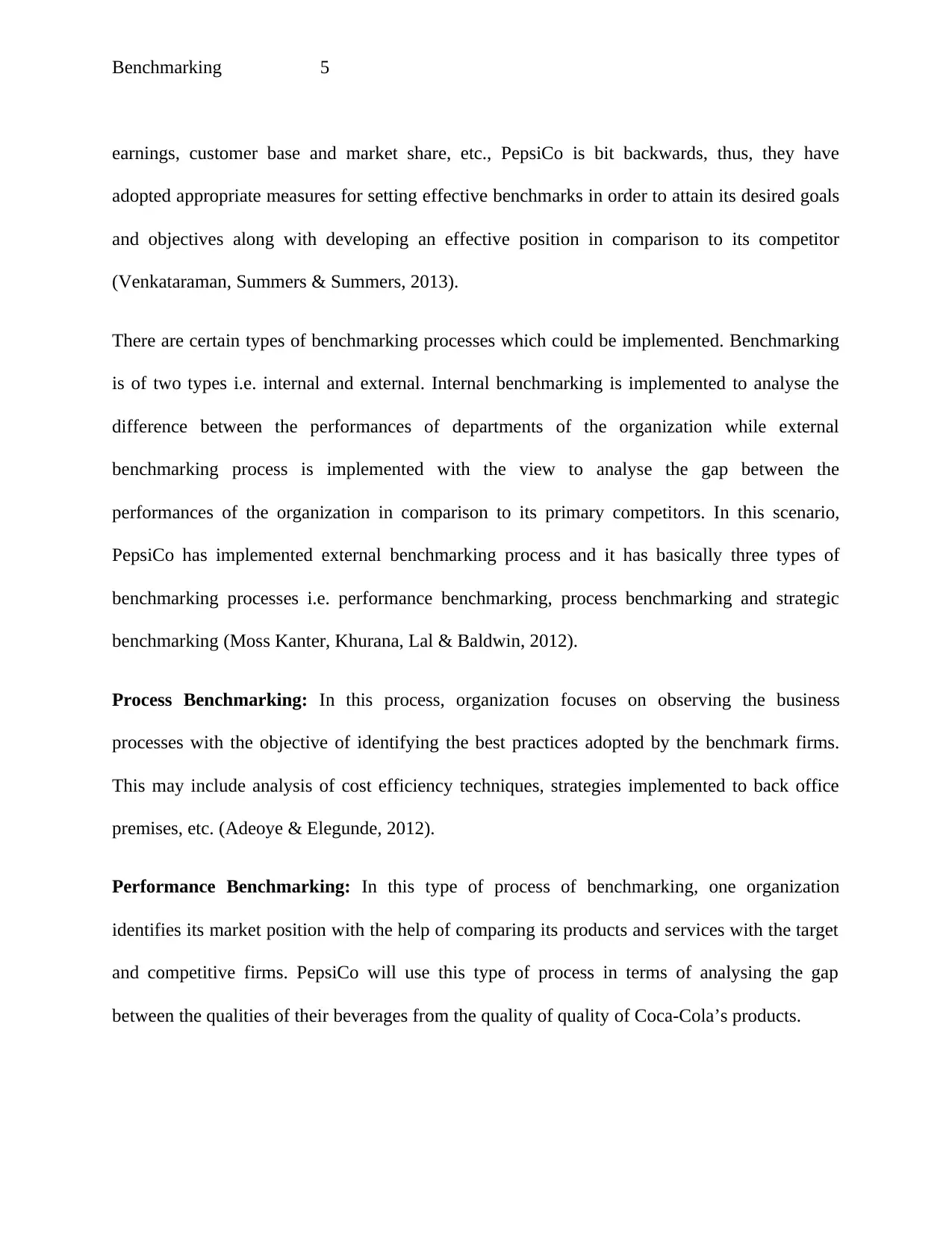
Benchmarking 5
earnings, customer base and market share, etc., PepsiCo is bit backwards, thus, they have
adopted appropriate measures for setting effective benchmarks in order to attain its desired goals
and objectives along with developing an effective position in comparison to its competitor
(Venkataraman, Summers & Summers, 2013).
There are certain types of benchmarking processes which could be implemented. Benchmarking
is of two types i.e. internal and external. Internal benchmarking is implemented to analyse the
difference between the performances of departments of the organization while external
benchmarking process is implemented with the view to analyse the gap between the
performances of the organization in comparison to its primary competitors. In this scenario,
PepsiCo has implemented external benchmarking process and it has basically three types of
benchmarking processes i.e. performance benchmarking, process benchmarking and strategic
benchmarking (Moss Kanter, Khurana, Lal & Baldwin, 2012).
Process Benchmarking: In this process, organization focuses on observing the business
processes with the objective of identifying the best practices adopted by the benchmark firms.
This may include analysis of cost efficiency techniques, strategies implemented to back office
premises, etc. (Adeoye & Elegunde, 2012).
Performance Benchmarking: In this type of process of benchmarking, one organization
identifies its market position with the help of comparing its products and services with the target
and competitive firms. PepsiCo will use this type of process in terms of analysing the gap
between the qualities of their beverages from the quality of quality of Coca-Cola’s products.
earnings, customer base and market share, etc., PepsiCo is bit backwards, thus, they have
adopted appropriate measures for setting effective benchmarks in order to attain its desired goals
and objectives along with developing an effective position in comparison to its competitor
(Venkataraman, Summers & Summers, 2013).
There are certain types of benchmarking processes which could be implemented. Benchmarking
is of two types i.e. internal and external. Internal benchmarking is implemented to analyse the
difference between the performances of departments of the organization while external
benchmarking process is implemented with the view to analyse the gap between the
performances of the organization in comparison to its primary competitors. In this scenario,
PepsiCo has implemented external benchmarking process and it has basically three types of
benchmarking processes i.e. performance benchmarking, process benchmarking and strategic
benchmarking (Moss Kanter, Khurana, Lal & Baldwin, 2012).
Process Benchmarking: In this process, organization focuses on observing the business
processes with the objective of identifying the best practices adopted by the benchmark firms.
This may include analysis of cost efficiency techniques, strategies implemented to back office
premises, etc. (Adeoye & Elegunde, 2012).
Performance Benchmarking: In this type of process of benchmarking, one organization
identifies its market position with the help of comparing its products and services with the target
and competitive firms. PepsiCo will use this type of process in terms of analysing the gap
between the qualities of their beverages from the quality of quality of Coca-Cola’s products.
⊘ This is a preview!⊘
Do you want full access?
Subscribe today to unlock all pages.

Trusted by 1+ million students worldwide
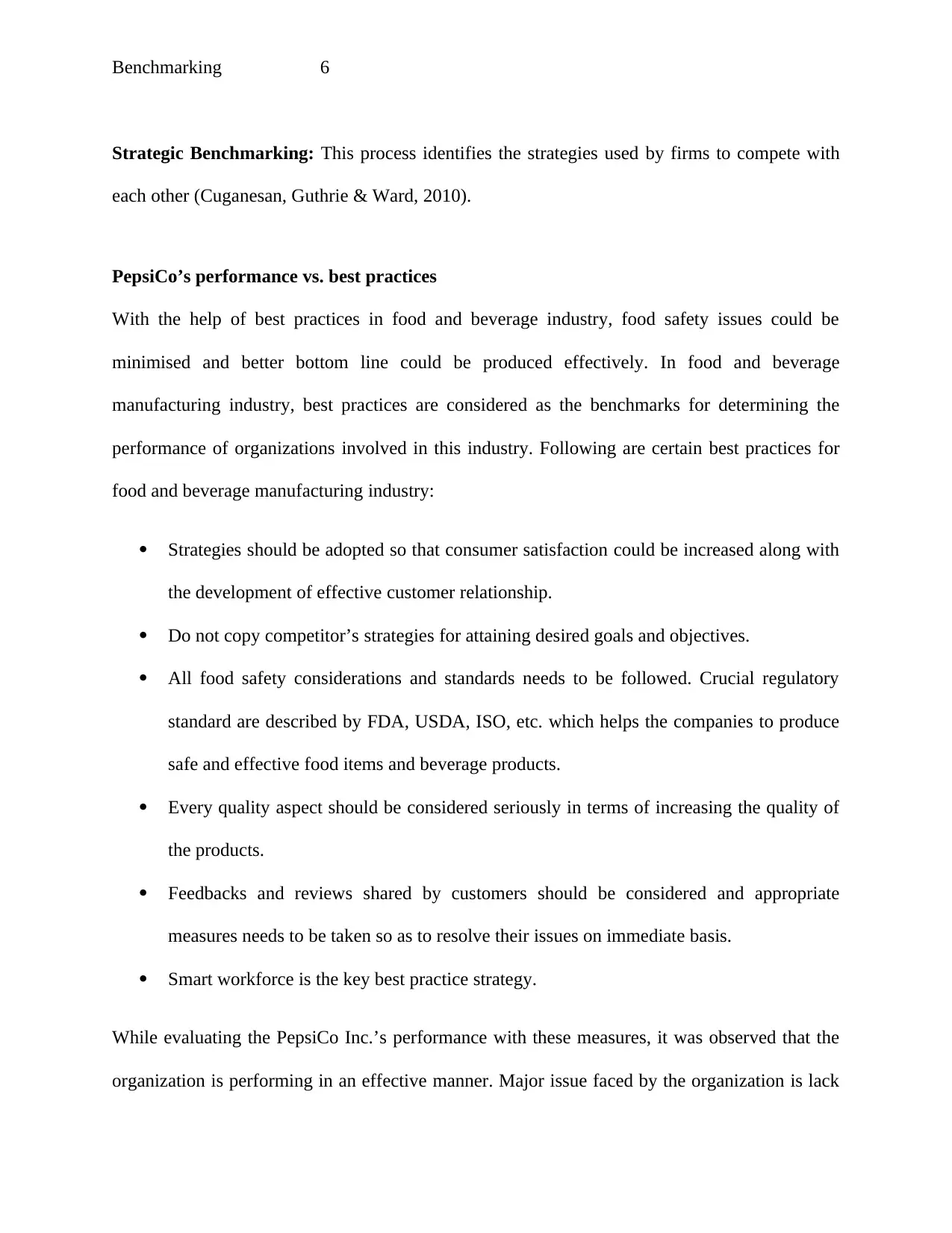
Benchmarking 6
Strategic Benchmarking: This process identifies the strategies used by firms to compete with
each other (Cuganesan, Guthrie & Ward, 2010).
PepsiCo’s performance vs. best practices
With the help of best practices in food and beverage industry, food safety issues could be
minimised and better bottom line could be produced effectively. In food and beverage
manufacturing industry, best practices are considered as the benchmarks for determining the
performance of organizations involved in this industry. Following are certain best practices for
food and beverage manufacturing industry:
Strategies should be adopted so that consumer satisfaction could be increased along with
the development of effective customer relationship.
Do not copy competitor’s strategies for attaining desired goals and objectives.
All food safety considerations and standards needs to be followed. Crucial regulatory
standard are described by FDA, USDA, ISO, etc. which helps the companies to produce
safe and effective food items and beverage products.
Every quality aspect should be considered seriously in terms of increasing the quality of
the products.
Feedbacks and reviews shared by customers should be considered and appropriate
measures needs to be taken so as to resolve their issues on immediate basis.
Smart workforce is the key best practice strategy.
While evaluating the PepsiCo Inc.’s performance with these measures, it was observed that the
organization is performing in an effective manner. Major issue faced by the organization is lack
Strategic Benchmarking: This process identifies the strategies used by firms to compete with
each other (Cuganesan, Guthrie & Ward, 2010).
PepsiCo’s performance vs. best practices
With the help of best practices in food and beverage industry, food safety issues could be
minimised and better bottom line could be produced effectively. In food and beverage
manufacturing industry, best practices are considered as the benchmarks for determining the
performance of organizations involved in this industry. Following are certain best practices for
food and beverage manufacturing industry:
Strategies should be adopted so that consumer satisfaction could be increased along with
the development of effective customer relationship.
Do not copy competitor’s strategies for attaining desired goals and objectives.
All food safety considerations and standards needs to be followed. Crucial regulatory
standard are described by FDA, USDA, ISO, etc. which helps the companies to produce
safe and effective food items and beverage products.
Every quality aspect should be considered seriously in terms of increasing the quality of
the products.
Feedbacks and reviews shared by customers should be considered and appropriate
measures needs to be taken so as to resolve their issues on immediate basis.
Smart workforce is the key best practice strategy.
While evaluating the PepsiCo Inc.’s performance with these measures, it was observed that the
organization is performing in an effective manner. Major issue faced by the organization is lack
Paraphrase This Document
Need a fresh take? Get an instant paraphrase of this document with our AI Paraphraser
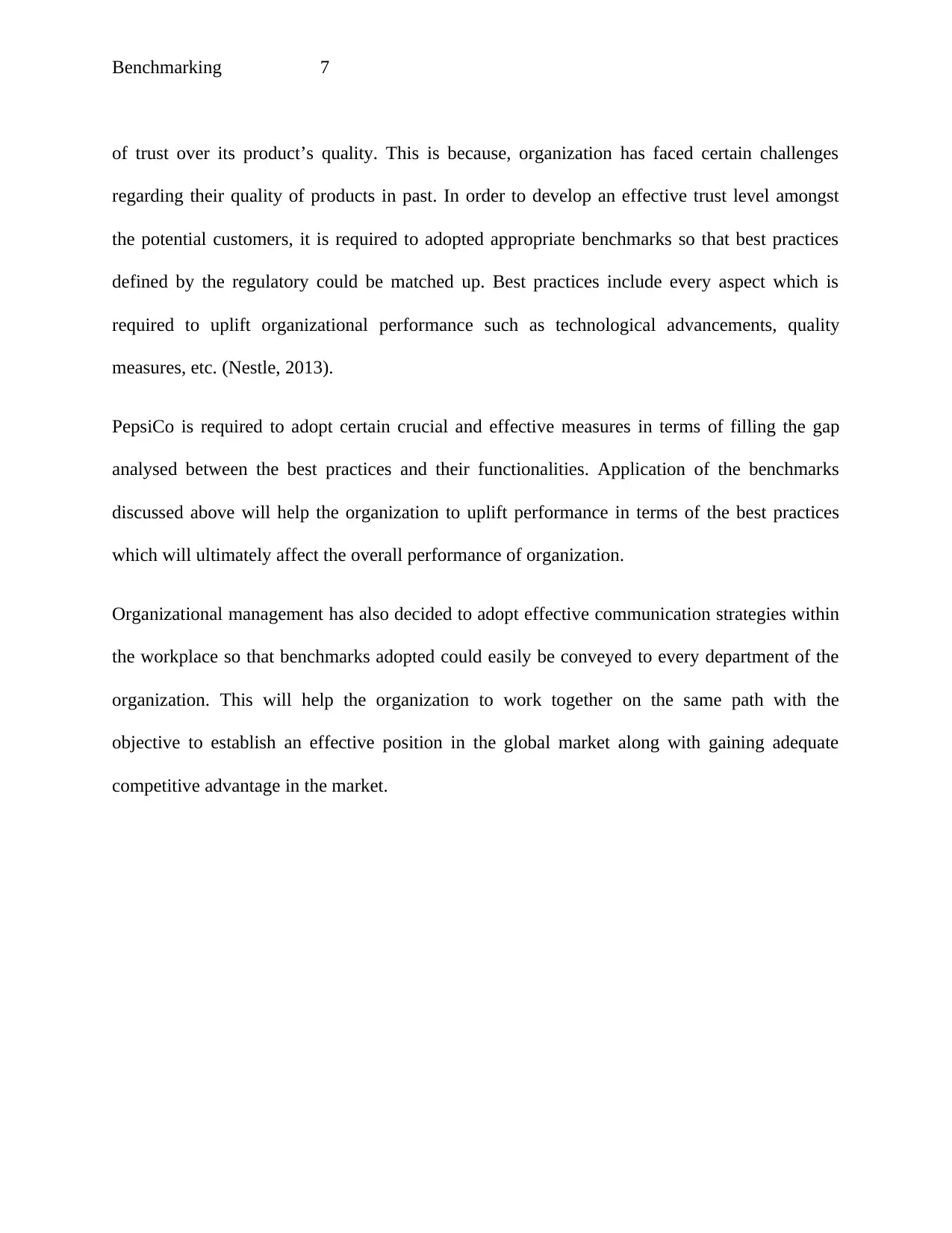
Benchmarking 7
of trust over its product’s quality. This is because, organization has faced certain challenges
regarding their quality of products in past. In order to develop an effective trust level amongst
the potential customers, it is required to adopted appropriate benchmarks so that best practices
defined by the regulatory could be matched up. Best practices include every aspect which is
required to uplift organizational performance such as technological advancements, quality
measures, etc. (Nestle, 2013).
PepsiCo is required to adopt certain crucial and effective measures in terms of filling the gap
analysed between the best practices and their functionalities. Application of the benchmarks
discussed above will help the organization to uplift performance in terms of the best practices
which will ultimately affect the overall performance of organization.
Organizational management has also decided to adopt effective communication strategies within
the workplace so that benchmarks adopted could easily be conveyed to every department of the
organization. This will help the organization to work together on the same path with the
objective to establish an effective position in the global market along with gaining adequate
competitive advantage in the market.
of trust over its product’s quality. This is because, organization has faced certain challenges
regarding their quality of products in past. In order to develop an effective trust level amongst
the potential customers, it is required to adopted appropriate benchmarks so that best practices
defined by the regulatory could be matched up. Best practices include every aspect which is
required to uplift organizational performance such as technological advancements, quality
measures, etc. (Nestle, 2013).
PepsiCo is required to adopt certain crucial and effective measures in terms of filling the gap
analysed between the best practices and their functionalities. Application of the benchmarks
discussed above will help the organization to uplift performance in terms of the best practices
which will ultimately affect the overall performance of organization.
Organizational management has also decided to adopt effective communication strategies within
the workplace so that benchmarks adopted could easily be conveyed to every department of the
organization. This will help the organization to work together on the same path with the
objective to establish an effective position in the global market along with gaining adequate
competitive advantage in the market.
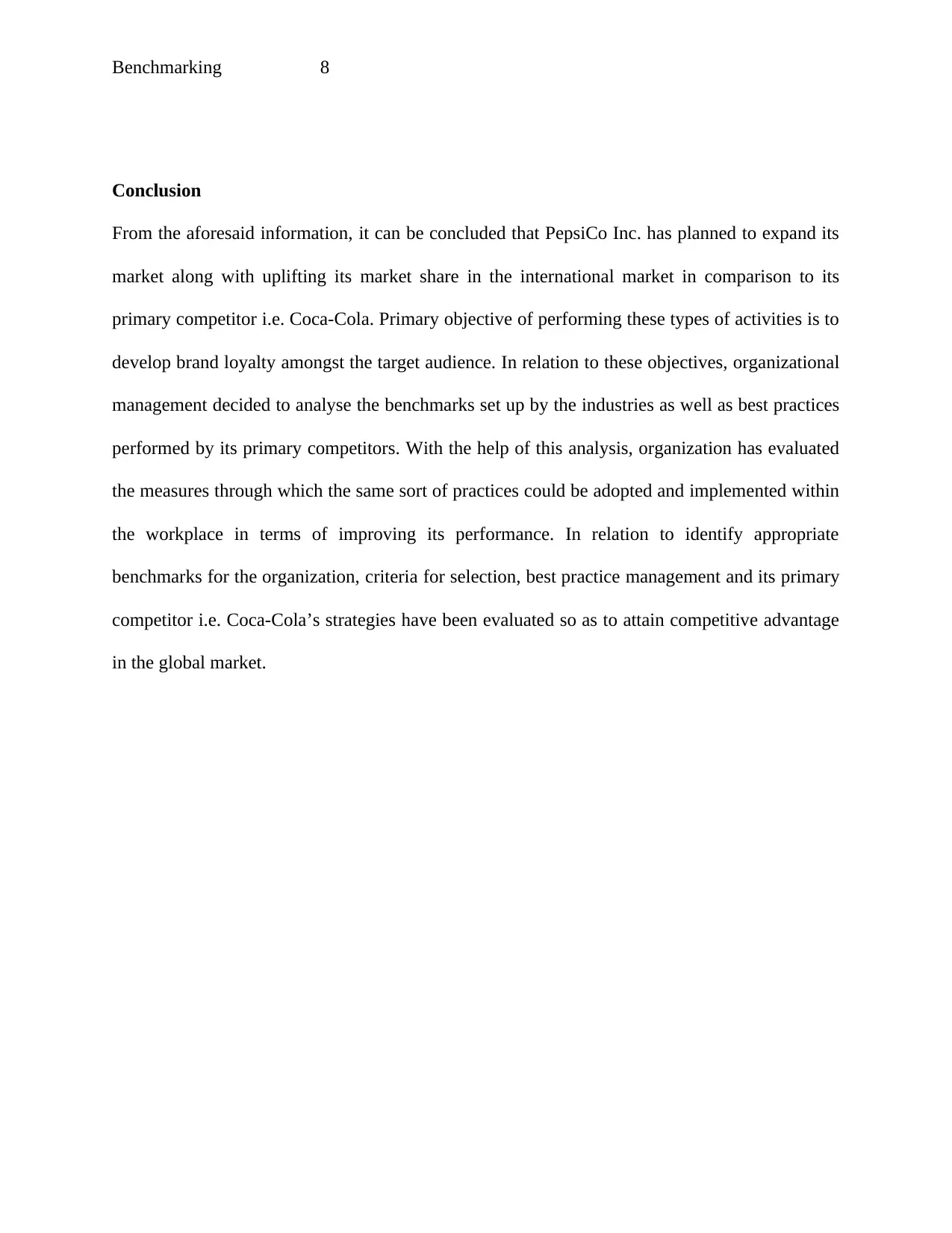
Benchmarking 8
Conclusion
From the aforesaid information, it can be concluded that PepsiCo Inc. has planned to expand its
market along with uplifting its market share in the international market in comparison to its
primary competitor i.e. Coca-Cola. Primary objective of performing these types of activities is to
develop brand loyalty amongst the target audience. In relation to these objectives, organizational
management decided to analyse the benchmarks set up by the industries as well as best practices
performed by its primary competitors. With the help of this analysis, organization has evaluated
the measures through which the same sort of practices could be adopted and implemented within
the workplace in terms of improving its performance. In relation to identify appropriate
benchmarks for the organization, criteria for selection, best practice management and its primary
competitor i.e. Coca-Cola’s strategies have been evaluated so as to attain competitive advantage
in the global market.
Conclusion
From the aforesaid information, it can be concluded that PepsiCo Inc. has planned to expand its
market along with uplifting its market share in the international market in comparison to its
primary competitor i.e. Coca-Cola. Primary objective of performing these types of activities is to
develop brand loyalty amongst the target audience. In relation to these objectives, organizational
management decided to analyse the benchmarks set up by the industries as well as best practices
performed by its primary competitors. With the help of this analysis, organization has evaluated
the measures through which the same sort of practices could be adopted and implemented within
the workplace in terms of improving its performance. In relation to identify appropriate
benchmarks for the organization, criteria for selection, best practice management and its primary
competitor i.e. Coca-Cola’s strategies have been evaluated so as to attain competitive advantage
in the global market.
⊘ This is a preview!⊘
Do you want full access?
Subscribe today to unlock all pages.

Trusted by 1+ million students worldwide
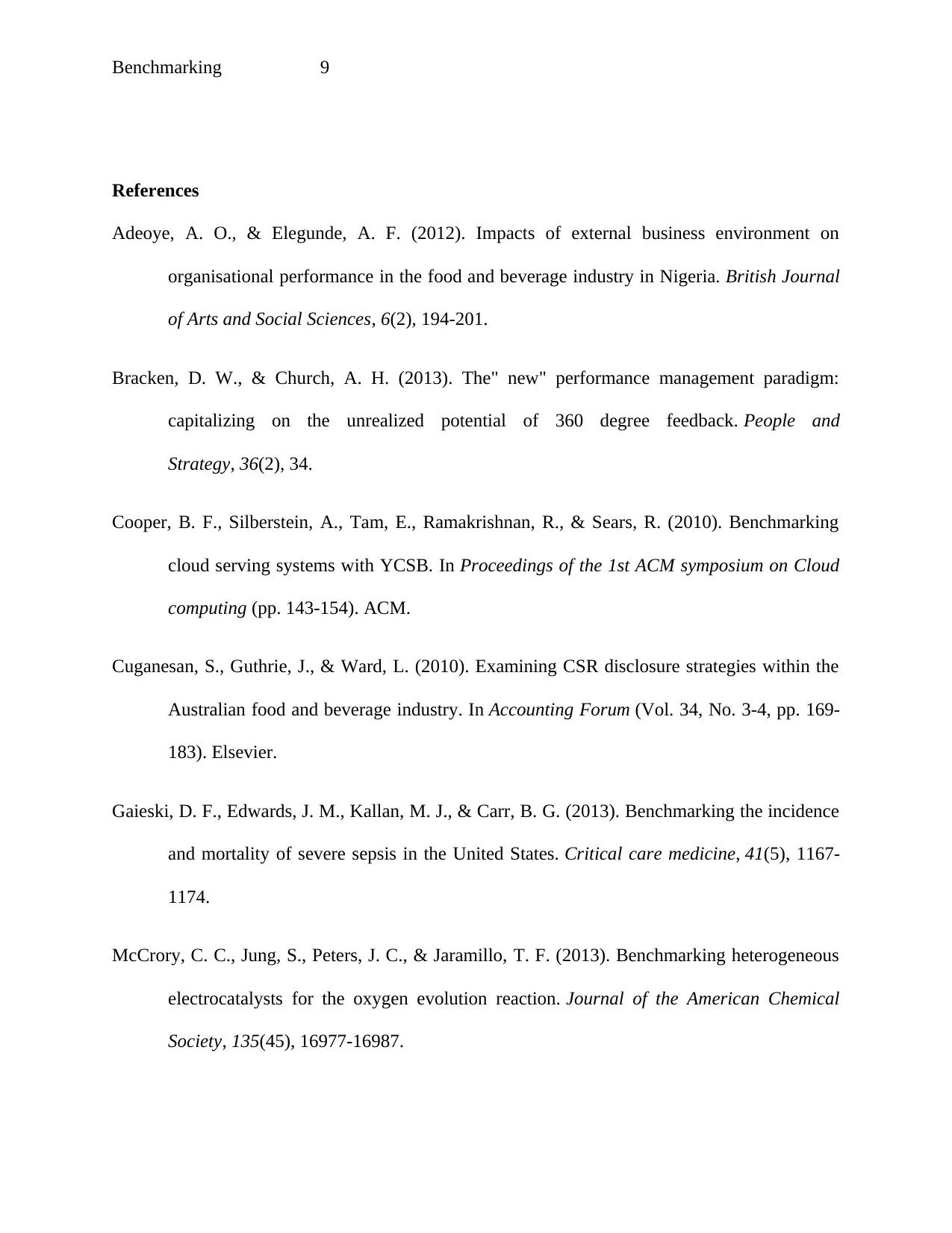
Benchmarking 9
References
Adeoye, A. O., & Elegunde, A. F. (2012). Impacts of external business environment on
organisational performance in the food and beverage industry in Nigeria. British Journal
of Arts and Social Sciences, 6(2), 194-201.
Bracken, D. W., & Church, A. H. (2013). The" new" performance management paradigm:
capitalizing on the unrealized potential of 360 degree feedback. People and
Strategy, 36(2), 34.
Cooper, B. F., Silberstein, A., Tam, E., Ramakrishnan, R., & Sears, R. (2010). Benchmarking
cloud serving systems with YCSB. In Proceedings of the 1st ACM symposium on Cloud
computing (pp. 143-154). ACM.
Cuganesan, S., Guthrie, J., & Ward, L. (2010). Examining CSR disclosure strategies within the
Australian food and beverage industry. In Accounting Forum (Vol. 34, No. 3-4, pp. 169-
183). Elsevier.
Gaieski, D. F., Edwards, J. M., Kallan, M. J., & Carr, B. G. (2013). Benchmarking the incidence
and mortality of severe sepsis in the United States. Critical care medicine, 41(5), 1167-
1174.
McCrory, C. C., Jung, S., Peters, J. C., & Jaramillo, T. F. (2013). Benchmarking heterogeneous
electrocatalysts for the oxygen evolution reaction. Journal of the American Chemical
Society, 135(45), 16977-16987.
References
Adeoye, A. O., & Elegunde, A. F. (2012). Impacts of external business environment on
organisational performance in the food and beverage industry in Nigeria. British Journal
of Arts and Social Sciences, 6(2), 194-201.
Bracken, D. W., & Church, A. H. (2013). The" new" performance management paradigm:
capitalizing on the unrealized potential of 360 degree feedback. People and
Strategy, 36(2), 34.
Cooper, B. F., Silberstein, A., Tam, E., Ramakrishnan, R., & Sears, R. (2010). Benchmarking
cloud serving systems with YCSB. In Proceedings of the 1st ACM symposium on Cloud
computing (pp. 143-154). ACM.
Cuganesan, S., Guthrie, J., & Ward, L. (2010). Examining CSR disclosure strategies within the
Australian food and beverage industry. In Accounting Forum (Vol. 34, No. 3-4, pp. 169-
183). Elsevier.
Gaieski, D. F., Edwards, J. M., Kallan, M. J., & Carr, B. G. (2013). Benchmarking the incidence
and mortality of severe sepsis in the United States. Critical care medicine, 41(5), 1167-
1174.
McCrory, C. C., Jung, S., Peters, J. C., & Jaramillo, T. F. (2013). Benchmarking heterogeneous
electrocatalysts for the oxygen evolution reaction. Journal of the American Chemical
Society, 135(45), 16977-16987.
Paraphrase This Document
Need a fresh take? Get an instant paraphrase of this document with our AI Paraphraser
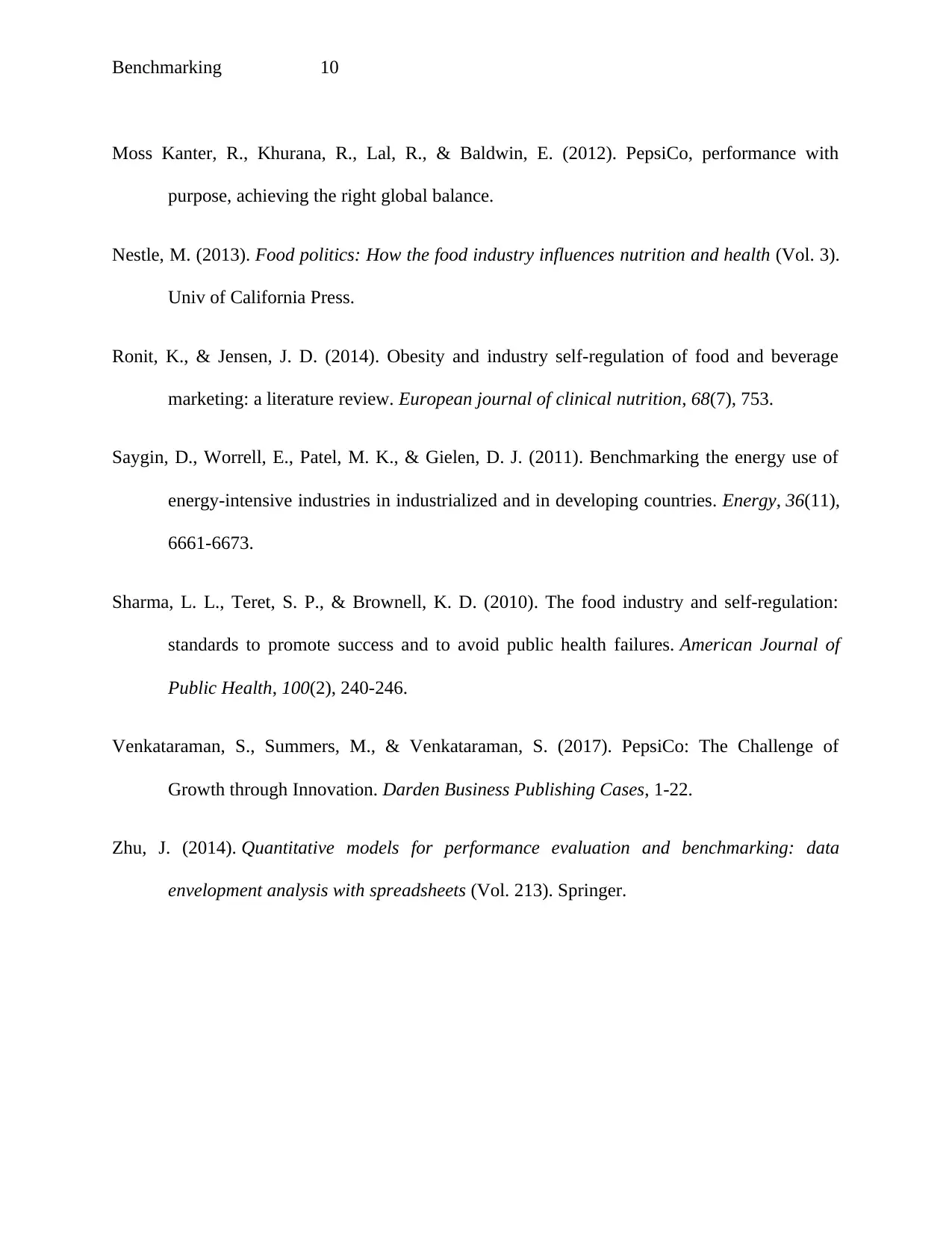
Benchmarking 10
Moss Kanter, R., Khurana, R., Lal, R., & Baldwin, E. (2012). PepsiCo, performance with
purpose, achieving the right global balance.
Nestle, M. (2013). Food politics: How the food industry influences nutrition and health (Vol. 3).
Univ of California Press.
Ronit, K., & Jensen, J. D. (2014). Obesity and industry self-regulation of food and beverage
marketing: a literature review. European journal of clinical nutrition, 68(7), 753.
Saygin, D., Worrell, E., Patel, M. K., & Gielen, D. J. (2011). Benchmarking the energy use of
energy-intensive industries in industrialized and in developing countries. Energy, 36(11),
6661-6673.
Sharma, L. L., Teret, S. P., & Brownell, K. D. (2010). The food industry and self-regulation:
standards to promote success and to avoid public health failures. American Journal of
Public Health, 100(2), 240-246.
Venkataraman, S., Summers, M., & Venkataraman, S. (2017). PepsiCo: The Challenge of
Growth through Innovation. Darden Business Publishing Cases, 1-22.
Zhu, J. (2014). Quantitative models for performance evaluation and benchmarking: data
envelopment analysis with spreadsheets (Vol. 213). Springer.
Moss Kanter, R., Khurana, R., Lal, R., & Baldwin, E. (2012). PepsiCo, performance with
purpose, achieving the right global balance.
Nestle, M. (2013). Food politics: How the food industry influences nutrition and health (Vol. 3).
Univ of California Press.
Ronit, K., & Jensen, J. D. (2014). Obesity and industry self-regulation of food and beverage
marketing: a literature review. European journal of clinical nutrition, 68(7), 753.
Saygin, D., Worrell, E., Patel, M. K., & Gielen, D. J. (2011). Benchmarking the energy use of
energy-intensive industries in industrialized and in developing countries. Energy, 36(11),
6661-6673.
Sharma, L. L., Teret, S. P., & Brownell, K. D. (2010). The food industry and self-regulation:
standards to promote success and to avoid public health failures. American Journal of
Public Health, 100(2), 240-246.
Venkataraman, S., Summers, M., & Venkataraman, S. (2017). PepsiCo: The Challenge of
Growth through Innovation. Darden Business Publishing Cases, 1-22.
Zhu, J. (2014). Quantitative models for performance evaluation and benchmarking: data
envelopment analysis with spreadsheets (Vol. 213). Springer.

Benchmarking 11
⊘ This is a preview!⊘
Do you want full access?
Subscribe today to unlock all pages.

Trusted by 1+ million students worldwide
1 out of 12
Related Documents
Your All-in-One AI-Powered Toolkit for Academic Success.
+13062052269
info@desklib.com
Available 24*7 on WhatsApp / Email
![[object Object]](/_next/static/media/star-bottom.7253800d.svg)
Unlock your academic potential
Copyright © 2020–2025 A2Z Services. All Rights Reserved. Developed and managed by ZUCOL.





